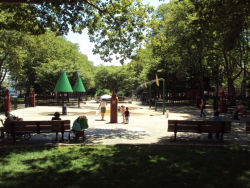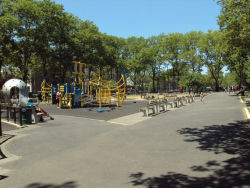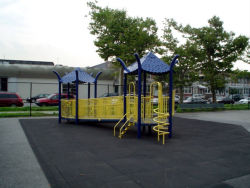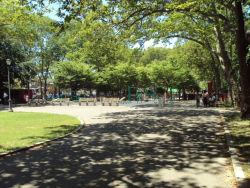Leif Ericson Park
Valhalla Courts
This site is part of Leif Ericson Park and is named for the hall in Norse mythology where the most valiant warriors, the Einherjar, are delivered after death.
No greater prize existed among pre-Christian Norse mythology than to be chosen by the one-eyed god, Odin, upon the completion of a grand adventure or a courageous death in battle. Brought into the halls of Valhalla, Odin’s private palace, by the nine semi-divine female valkyrs, and set before a long table beside history’s greatest warriors, the chosen adventurer would be inducted into the Einherjar.
As Odin’s vanguard of warriors, the Einherjar were granted the privilege of sparring with their fellows by day and dining sumptuously with Odin by night until the coming of Ragnarok, the Twilight of the Gods. At the end of time, it was prophesied that Odin would lead his armies against the forces of darkness in one final hopeless battle. The Einherjar would hold the honor of being positioned at the head of the army of Norse gods.
Leif Ericson (c.960-c.1020) was probably the first European to set foot on the American continent, nearly 500 years before Christopher Columbus’s (1451-1505) voyages. Ericson never colonized the land in his two voyages to the continent, however, due to a harsh winter and attacks from native warriors, and he returned to Greenland with his men in 1001.
Eight centuries after Ericson’s Atlantic voyage, Norwegians began to migrate to American shores. A large number arrived in New York after 1825, and many made their homes in Brooklyn. By the turn of the century, the neighborhood of Bay Ridge supported a variety of Norwegian cultural, charitable, and business institutions.
In 1925, community leaders persuaded City Hall to create a new public park on five vacant, city-owned blocks from Fourth Avenue to Fort Hamilton Parkway between 66th and 67th Streets. The land acquired in 1895-97 for part of the Bay Ridge Parkway (later built as a widened 75th Street) was then named for Ericson. A crowd of 15,000 attended the park dedication, at which Mayor John F. Hylan, Norwegian Consul General Hans Fay, and Nordisk Tidende editor A.N. Rygg spoke.
Parks landscaped and equipped the new facility in 1934-35. Each of the five blocks featured different amenities, including separate playgrounds for girls, boys, and small children; a planted park for passive enjoyment; and ten tennis courts. In 1939 Crown Prince Olav of Norway dedicated a monument to Leif Ericson at the Fourth Avenue entrance to the park. The two bronze relief tablets mounted on granite in the shape of a rune stone were created by artist August Werner. During World War II (1939-1945) the U.S. Army occupied the property; and Parks rehabilitated the site after it was evacuated in May 1945.
The park design features a Norse theme in honor of Leif Ericson and the local Scandinavian-American community. Among the many Norse motifs are a statue of a troll holding a “bearing dial” (compass), columns decorated like turrets of the Borgund Church, and medallions depicting snowflakes and Norwegian animals. Two attractive signs welcome visitors to the park: a new steel panel portraying a scene of rural Norway and a recently restored cast-iron sign shaped like a Viking ship.
Check out your park's Vital Signs
Clean & Safe
Green & Resilient
Empowered & Engaged Users
Share your feedback or learn more about how this park is part of a
Vital Park System




